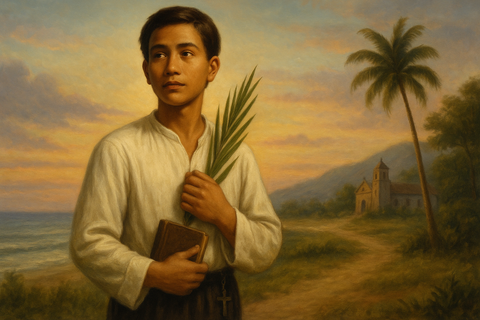In the mid-17th century, in the sun-drenched islands of the Visayas, a boy was growing in faith and simplicity. Though the exact year and place of his birth remain uncertain, most historians agree he was born around 1654 somewhere in the Visayan region of the Philippines (likely in what is now Cebu, Leyte or Iloilo).
From his youth he showed a love for the faith, learning the catechism and serving the Church in ways only his small community might have noticed. But God was preparing him for something far greater.
Training and Mission
As a teenager he came under the influence of Fr. Diego Luis de San Vitores and the Jesuit missionaries who were establishing a mission among the native peoples of the Marianas Islands.
Around 1668, when he was about 14 or 15, Pedro accepted a grave and joyful invitation: to travel with the Jesuits from the Philippines to the Islas de los Ladrones (today’s Marianas Islands). There, he would serve as a lay catechist and missionary helper, bringing the faith to people who had never heard the Gospel.
The journey was arduous. The mission land was remote, the climate tropical and unforgiving, and supplies scarce. Pedro learned Spanish; he worked as sacristan, catechist, teacher; he ministered to children; he walked through dense jungles and visited villages with his mentor Father San Vitores.
Faith in a Foreign Land
On the island of Guam—among the indigenous Chamorro people—Pedro’s cheerful spirit and humility became a witness. He taught prayers, he led catechism classes, he assisted in baptisms and Masses. The mission’s intention was to share the love of Christ, yet the cultural and political dynamics of the time made this mission fragile and contested.
One factor of tension: rumors spread among the Chamorro that the missionaries’ baptismal water was poisonous, especially when some sickly infants who had been baptized died soon after. This caused suspicion and fear, making Pedro’s mission very dangerous.
The Final Day: April 2 1672
It was on a morning of stillness and promise that everything shifted. On April 2, 1672, Pedro accompanied Father San Vitores to the village of Tumon on Guam to baptize a Christian mother’s child at her request.
While the priest baptized the child, the village chief Matå’pang, incensed by the rumour-filled fears about baptism, gathered compatriots and attacked. Pedro could have fled—he was young, swift, and unarmed—but he chose to stand with his mentor.
The attackers struck: Pedro was wounded in the chest; Father San Vitores then absolved him before also being killed. Their bodies were tied to stones and thrown into the sea.
Thus, in his youth (he is believed to have been about 17–18 years old), Pedro laid down his life as a martyr for the faith.
From Martyr to Saint
Though his life was short, Pedro’s witness rippled through history. On March 5, 2000, Pope John Paul II beatified him, recognizing him as a martyr.
Then, on October 21, 2012, Pope Benedict XVI canonized him as a saint in Rome, making him the second Filipino saint after Saint Lorenzo Ruiz.
He is now venerated as Patron of Filipino youth, catechists, and evangelizers. His feast day has been celebrated on April 2 (the day of his martyrdom).
A Young Saint for Our Time
Saint Pedro Calungsod stands as a guiding star especially for young people: those questioning, seeking purpose, longing to serve. He says to us: “Here I am. Use me, Lord.”
In a world saturated with distractions and shallow definitions of success, his life whispers: Mount your dreams on the One who never fails.
Invite him into your heart, carry his rosary, and walk in his footsteps—even in simple acts of kindness. Saint Pedro Calungsod, pray for us.

